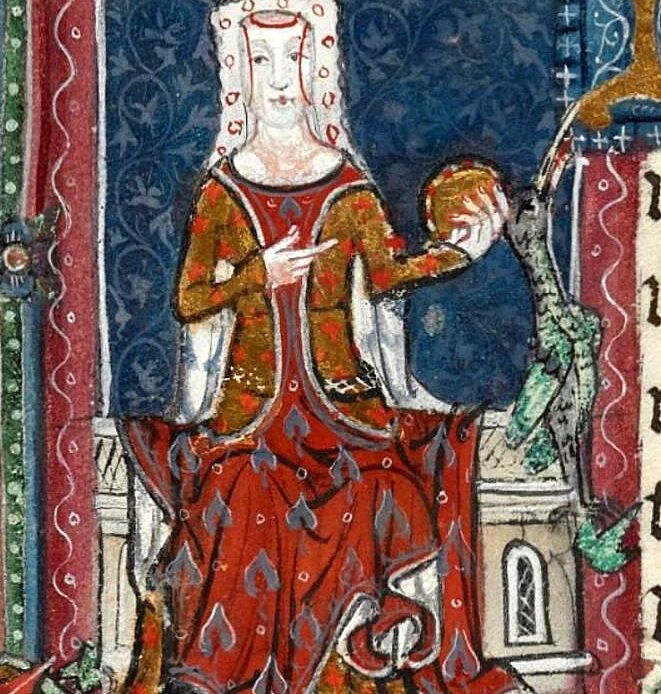
On the 7th of August, 1385, Joan of Kent, Princess of Wales and Countess of Kent, passed away at Wallingford Castle. Her death marked the end of a remarkable life woven through scandal, devotion, and dynastic politics. Known to her contemporaries as “the Fair Maid of Kent,” Joan was more than a figure of beauty; she was the mother of a future king, the consort of one of England’s most celebrated princes, and a woman whose personal choices at times defied the expectations of her station.
Joan’s life story reads like a medieval romance, but her death — quiet, dignified, and surrounded by family — reveals a woman whose legacy was ultimately secured not just through passion and controversy, but through her role in England’s dynastic future.
A Royal by Birth — and by Drama
Joan was born in 1328 into a world steeped in Plantagenet intrigue. Her father, Edmund of Woodstock, was the youngest son of Edward I and half-brother to Edward II. When Edmund was executed for treason in 1330 — allegedly for plotting to restore Edward II after his deposition — Joan was only two years old. The shadow of that execution would linger over her early life, leaving her family in relative disgrace, though her royal blood still granted her proximity to power.
That proximity would lead to one of the most scandalous episodes of her life. Around 1340, Joan secretly married Sir Thomas Holland, a knight in the royal household. However, during his absence on campaign, she was coerced into a second marriage — to William Montagu, heir to the Earl of Salisbury. A legal battle ensued, reaching even the Pope, and by 1349 the first marriage was declared valid. Holland was restored as her lawful husband, and they had several children together before his death in 1360.
The Black Prince and a Political Alliance
Following Holland’s death, Joan made a politically advantageous — and, some whispered, long-anticipated — marriage to Edward of Woodstock, better known as the Black Prince. As the eldest son of Edward III and England’s military hero during the early stages of the Hundred Years’ War, Edward represented the apex of Plantagenet prestige.
Their union in 1361 cemented Joan’s position at the heart of English power. She became Princess of Wales and was the mother of Edward’s two sons — the younger of whom, Richard of Bordeaux, would succeed his grandfather as King Richard II in 1377.
Despite the glamour of her position, Joan’s years as Princess of Wales were marked by illness and political strain. Edward the Black Prince, once the darling of the English court, suffered from debilitating health problems likely linked to dysentery contracted during the Spanish campaign of 1367. His death in 1376, just a year before that of Edward III, left Joan a widow once again and placed her young son at the centre of political attention.
Queen Mother in All but Name
Joan’s final years were defined by her role as the mother of the king. Though never crowned queen, she acted as a matriarchal figure within the young king’s court. Richard II, only ten when he inherited the throne, relied heavily on her counsel. She provided a measure of stability in a kingdom torn by competing noble factions and social unrest, including the Peasants’ Revolt of 1381.
Her reputation for diplomacy and discretion was most famously on display in 1384, when she intervened to protect two of her favourites, John Holland and Ralph Stafford, from the wrath of her son after a fatal altercation between the two men. Her intercession — reportedly made on her knees — was a powerful display of her moral authority at court.
It was during this period, likely worn by years of courtly conflict and advancing age, that Joan’s health began to fail. She retired to Wallingford Castle, a favoured royal residence, where she died peacefully on 7 August 1385 at the age of approximately 56.
Burial, Legacy, and Memory
Joan was buried beside her first husband, Thomas Holland, in the Greyfriars Church in Stamford, rather than alongside the Black Prince in Canterbury Cathedral. This decision has intrigued historians, suggesting perhaps that her greatest emotional attachment remained with Holland, the man she fought so hard to marry in her youth.
In her will, Joan demonstrated a deep concern for religious observance, asking for hundreds of masses to be said for her soul, as well as displaying generosity to her servants and various religious houses. It is a poignant testament to a woman who had played the game of power at the highest levels, but who died seeking peace and remembrance.
Though her son Richard II would be deposed in 1399, Joan’s lineage continued to shape the course of English history. Through her descendants, she is connected to the Beaufort line and, ultimately, the Tudor dynasty.
Joan of Kent’s life was lived in the long shadow of England’s great Plantagenet drama. Her death, quiet and dignified, might appear unremarkable when compared to the tempestuous episodes of her youth, but it marked the end of an era. A mother to a king, a consort to a hero, and a woman of will and complexity, Joan remains one of the most fascinating figures of 14th-century England.

